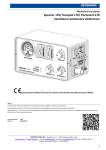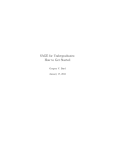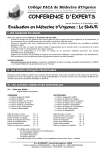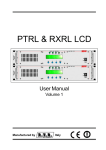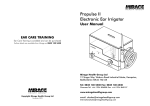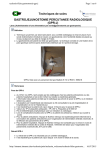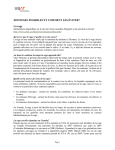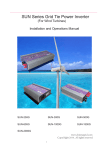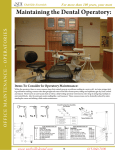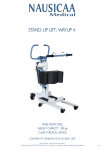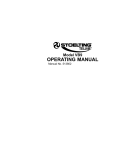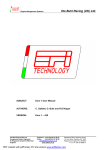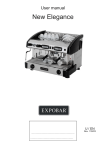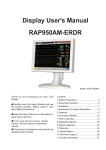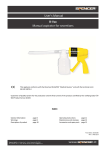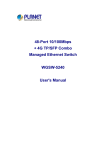Download Spencer 190 - Spencer Italia S.r.l.
Transcript
User manual Spencer 190/ Kompak 190/ Portavent 190 Electronic pulmonary ventilator 0123 Class IIb Medical Device, compliant with the Medical device directive 93/42/CE Warning The information contained in this manual is subject to change without notice. The Diagrams are inserted only for reference and may vary slightly from the actual device. Spencer Italia S.r.l. assumes no responsibility for any errors contained herein or for damage, accidents or consequences connected with the supply, performance or use of this manual. First edition: Rev. 11: 1998 09/03/2015 SPENCER ITALIA SRL – Strada Cavi n° 7 – 43044 Collecchio (PR) - Italy www.spencer.it | support.spencer.it - e-mail: [email protected] | service: [email protected] |Ph./Tel. +39.0521.541111 Quality System EN ISO 9001 – EN ISO 13485 1 INDEX 1. MODELS 3 2. INTENDED USE 3 3. REFERENCE STANDARDS 3 4. INTRODUCTION 3 4.1 Use of the manual 3 4.2 Labelling and tracking control of the device 3 4.3 Symbols 4 4.4 Warranty and support 5 5. WARNINGS 5 6. SPECIFIC WARNINGS 7 6.1 Requirements of operators 8 7. RESIDUAL RISK 8 8. TECHNICAL DATA AND COMPONENTS 9 8.1 Technical data 8.2 Components 8.3 Pneumatic diagram 9. INSTALLATION AND START-UP 9 10 11 11 9.1 Installation 11 9.2 Start - up 13 10. FUNCTIONAL CHARACTERISTICS 14 11. INSTRUCTIONS FOR USE 15 11.1 Principle of operation 15 11.2 Operating modes 15 11.3 Usage 16 11.4 Alarms 12. CLEANING AND MAINTENANCE 16 18 12.1 Cleaning 18 12.2 Precautionary maintenance 18 12.3 Periodic maintenance 20 12.4 Special servicing 20 12.5 Life span 13. TROUBLESHOOTING 13.1 How to return for servicing 20 21 21 14. ACCESSORIES 22 15. SPARE PARTS 22 16. DEMOLITION 22 Warning The information contained in this document could be modified without any warning and is not to be intended as a commitment on behalf of Spencer Italia S.r.l. Spencer products are exported to many countries and the same identical regulations are not always valid. For this reason there could be differences between the description here described and the product actually delivered. Spencer continually strives to reach the perfection of all items sold. We therefore hope you will understand if we reserve the right, at any time, to modify the shape, equipment, lay-out or technical aspects that are herein described. © Copyright Spencer Italia S.r.l. All rights reserved. No part of this document can be photocopied, reproduced or translated into another language without the written approval of Spencer Italia S.r.l. 2 1. MODELS The standard following models can undergo change, revision and implementation without any notice. Spencer 190 Electronic pulmonary ventilator Kompak 190 Resuscitation system Porta Vent 190 Backpack resuscitation system The connection standard of the device is the one determined by the customer on the order. 2. INTENDED USE Spencer 190 is a breathing control/assistance volumetric device, with electronic control of the respiratory function, capable of delivering two different concentrations of medical gas with a single gas supply, equipped with mechanical and electronic safety systems able to monitor some of the main breathing parameters. The range of volumes, respiratoy frequencies and monitoring systems for the safety of the patient, allow its use in both adults and children. Is not indicated for use with newborns. The device substitutes temporarily the breathing functions in those patients who are not able to breathe spontaneously. Spencer 190 is intended to be installed inside a medical vehicle. Kompak and Portavent are transportable systems, with a time of use strictly related to the battery life time and to the autonomy of the medical gas supply. 3. REFERENCE STANDARDS As a distributor or end user of products manufactured and/or marketed by Spencer Italia S.r.l. you are strictly required to have basic knowledge of any legal requirements applying to the devices contained in this supply that are in power in the goods final destination Country (including laws and norms regarding technical specifications and/or safety requirements) and therefore you are strictly required to have the necessary knowledge to guarantee all aspects regarding the total conformity of the products to the regulations in the relevant territory. REFERENCE UNI EN 1789 EN 794-3 CEI EN 60601-1 EN 60601-1-2 Regulation 10 TITLE OF DOCUMENT Medical vehicles and their equipment - Road ambulances Lung ventilators. Part 3: Particular requirements for emergency and transport ventilators. Medical electrical equipment - Part 1: General requirements for basic safety and essential performance Medical electrical equipment - part 1: general requirements for safety 2. Collateral standard: electromagnetic compatibility - requirements and tests Uniform provisions concerning the approval of vehicles with regard to electromagnetic compatibility 4. INTRODUCTION 4.1 Use of the manual This manual is intended to provide the health care operator with the all the necessary information for its safe and appropriate use as well as adequate maintenance of the device Note: The manual is an integral part of the device. It must be kept for the duration of the device and must accompany the device in case of change of ownership or destination. If the operating instructions received relate to products not received, you must immediately contact the manufacturer before use. The Spencer product manuals can be downloaded from the website or can be requested by http://support.spencer.it or by contacting the manufacturer. Exceptions are items whose essentiality for reasonable and predictable use is such as to make it unnecessary to prepare instructions in addition to the following warnings and directions on the label. Regardless of the level of experience gained in the past with similar devices, it is recommended that you carefully read this manual before installing, operating or using the product or any maintenance 4.2 Labelling and tracking control of the device Each device has got an identification label positioned on the device itself and/or on its box, which includes identification data about the manufacturer, the product, the CE mark, the serial number (SN) or lot number (LOT). It must never be removed or covered. In case of damage or loss, request a duplicate from the manufacturer. Failure to do so will interrupt the validity of the guarantee as the device can no longer be traced. The Directive 93/42/EEC requires manufacturers and distributors of medical devices to keep track of the device location. If the device was in a different location to the address where it was sent or to where it had been sold, donated, lost, stolen, exported, or destroyed, permanently removed from use, or if the device had not been delivered directly from Spencer Italia S.r.l., register your device at http://service.spencer.it or inform the customer (see § 4.4). 3 4.3 SYMBOLS Symbol Meaning General or specific warnings See instructions for use Do not lubricate Lot number Product code Serial number 0123 Prodotto conforme ai requisiti previsti nella Direttiva 93/42/CEE The device must be used before the date indicated on the package (Accessories) Protection against electric shock Class II B Type device ~ 12 V DC Alternating current Direct current Fuse Hz Frequency (where applicable) Keep in a cool and dry place Storage temperature Warning for the correct disposal of the product according to the European Directive 2012/19/UE Information to the users in compliancy with comma 22 of the Italian Legislative Decree of 20 November 2008, n. 188 “Actuation of the Directive 2006/66/CE regarding batteries, accumulators and their wastes and that repeals Directive 91/157/CEE” I O ON OFF 12V Rechargeable battery 9V backup battery Non-ionising radiation EMC Electromagnetic compatibility Obligation to read operating instructions 4 4.4 Warranty and support Spencer Italia S.r.l. guarantees that products are without defects for a period of one year from the date of purchase. For any information regarding the correct interpretation of the instruction manual, the use, maintenance, installation and restore of the product, contact the Spencer customer care service ph. +39.0521.541111, fax +39.0521.541222 or e-mail [email protected]. In order to facilitate the assistance service, please always indicate the lot number (LOT) or serial number (SN) shown on the label applied on the box or on the device. Conditions for warranty and assistance can be viewed on http://support.spencer.it. Note: Record and store; these instructions, lot (LOT) or serial number (SN) if any, date and place of purchase, date of first use, date servicing, user names and comments. 5. WARNINGS The warnings, notes and other important safety information are indicated in this section and are clearly visible throughout the entire manual. User training Note: Laboratory testing, post production tests, instruction manuals cannot always consider every possible scenario for use. This means that in some cases the performance of the product could be notable different from results to date obtained. The best instructions consist in continuous practice under the supervision of trained and competent staff. Regardless of the level of experience gained previously with similar devices, it is recommended that you carefully read this manual before installing, operating or using the product or carrying out any maintenance. If in doubt, contact Spencer Italia S.r.l. to obtain the necessary clarifications. The product must be used by trained personnel only, having attended specific training for this device and not for similar products, with appropriate clinical knowledge in the field of artificial ventilation in order to correctly set the values available on the device according to the patient’s clinical status. The suitability of the user to use the product may be attested by the records of training, where the names of those trained, of the trainers, dates and place are Indicated. This register which certifies the eligibility of the operators to use the Spencer device must be kept for a period of 10 years after the disposal of the device itself. This register will be made available to the competent Authorities and/or manufacturer if requested. In the absence of such documentation, sanctions will be applied. Do not allow any untrained person to help during the use of the device, because they could cause damage to the patient or to themselves. Note: Spencer Italia S.r.l. is always at your disposal to organise product training. Installers training The installer of the device must be able to ensure that all equipment, systems, containers and connections comply with their specific safety standards and regulations. This requires knowledge of all regulations and standards applicable. In the particular case of connection to the main supply through a power adapter, this need to be compliant with IEC 60601-1, EN 60601-1-2 standards and periodic checks as prescribed by EN 62353 need to be established before the installation of the device. If these conditions are not met, safety of the device and for the operators will be compromised. Product functionality Use of the device in anyway other than described in this manual is forbidden. Before each use of device the perfect operating state of the device must be checked as specified in the instruction manual. If any damage or abnormalities which could in any way influence the correct functioning and the safety of the device are detected, the device must be immediately removed from service and the manufacturer must be contacted. If any failure or incorrect functioning of the device is detected, it must be immediately substituted with a similar item so that the rescue procedures are guaranteed without any interruption. The appliance must not in any way be tampered with (modification, adjustment, addition, replacement). In such cases all responsibility will be denied for any malfunctions or injuries caused by the appliance itself; moreover CE certification and product warranty will be considered void Those who modify or have modified, prepare or have prepared medical appliances in such a way that they no longer serve the purpose for which they were intended, or no longer supply the intended service, must satisfy the valid conditions for the introduction onto the market. During use, position and adjust the device taking care not to cause any obstruction to rescuers and or any other rescue equipment. Ensure that all the necessary precautions are taken in order to avoid the hazards that can arise as the result of contact with blood or body fluids, when applicable. Ensure that the fixing system is suitable to keep fixed the device in the medical vehicle in all circumstances. The warranty seals, where present, must not be removed; in such case, the manufacturer will no longer recognize the product warranty and will accept no responsibility in case of incorrect operation or damage caused by the product itself. Avoid contact with sharp objects. Operating temperature: from -10°C to +40°C 5 Storage The device should not be exposed to or come into contact with any source of combustion or inflammable agents. Store in a cool, dry, dark place and do not expose to direct sun. Do not store the device underneath any heavy objects which could cause structural damage. Store and transport the device in its original packaging. Failure to do so makes the warranty void. Storage temperature: from -10°C to + 60°C Maintenance/cleaning Spencer Italia S.r.l. disclaims any liability for any damage, direct or indirect, which is a result of improper use of the product and replacement parts and / or otherwise of any repairs made by an entity other than the authorized Spencer service centres; this will also invalidate the warranty. The operator must always wear adequate personal protection such as gloves and mask etc. during all checking, maintenance and cleaning procedures. Establish a maintenance program and periodic testing, identifying an employee responsible for overseeing. The person to whom the ordinary maintenance of the device is entrusted must ensure the basic requirements foreseen by the manufacturer in the user’s manual. The frequency of inspection is determined by factors such as legal requirements, the type of use, frequency of use, environmental conditions during use and storage. Spencer Italia S.r.l. disclaims any liability for any damage, direct or indirect, that is the result of incorrect repairs or use of products made by Spencer Italia S.r.l. Repairs must necessarily be carried out by an authorized Spencer Italia service centre, which in using original spare parts will provide a quality repair service in strict accordance with the technical specifications given by the manufacturer. Spencer Italia S.r.l. disclaims any liability for any damage, direct or indirect, which is a result of improper use of spare parts and/or otherwise of any repairs made by an entity other than the Spencer service centres authorized to repair or make substitutions on this product and parts and/or otherwise of any repairs made by an entity other than the Spencer service centres authorized to do so; the warranty will also be invalidated. Use only original components, spare parts and or accessories, approved by Spencer Italia S.r.l., in order to carry out any operation without causing any alteration or modification to the device. All maintenance and revision must be recorded and documented with the corresponding report for technical assistance; documentation shall be maintained for at least 10 years from the end of life and must be made available to the competent authorities and/or the manufacturer if requested. The cleaning schedule for reusable products must be performed in accordance with the directions provided by the manufacturer in the user manual, in order to avoid the risk of cross-infection due to the presence of secretions and/or residuals. The device and all its components, after washing, should be allowed to dry completely before storing. Regulatory requirements As a distributor or end user of products manufactured and/or marketed by Spencer Italia S.r.l., you are strictly required to have a basic knowledge of any legal requirements applying to the devices contained in this supply that are in power in the final destination Country (including laws and norms regarding technical specifications and/or safety requirements) of the goods and therefore you are also strictly required to have the necessary knowledge to guarantee all aspects regarding the total conformity of the products to the regulations in the relevant territory. Promptly notify Spencer Italia S.r.l. (already during the first product enquiry) when requesting in details regarding any revisions to be made by manufacturer in order to guarantee the conformity of the products to the territory’s legal specifications (including those resulting from rules and/or norms of other kind). Act, with all due care and diligence, and contribute to ensure conformity to general safety requirements of all devices marketed in the territory, by providing final users with all necessary information for carrying out periodical checks on their devices, exactly as specified in the relevant user’s manual. Actively contribute to safety checks on product sold, by communicating any relevant risk analysis information both to the manufacturer and to any competent authorities so that the necessary action can be promptly taken. The distributor or final user is aware that in the event of any failure to conform to the above mentioned requirements you will be deemed fully responsible for all damages that might occur. Therefore Spencer Italia S.r.l. expressly disclaims any responsibility and/or liability for your non-compliance with the present regulatory provisions. General warnings for medical devices The user must carefully read not only these general warnings, but also those listed below. It is not foreseen that the use of the device is prolonged beyond the time necessary for the first responders to the complete their operation and the subsequent stages of transport to the nearest rescue point. When the device is being used, the assistance of qualified staff must be guaranteed and at least one operator must be present. Follow the procedures and protocols approved by the internal organization. If disposable accessories are used, use only once and for only one patient. Do not wash or sterilize after use. Reuse may cause cross infection. Some symbols contained in this manual refer to the standard accessories included In the purchased device. The activities of disinfection and sterilization should be carried out in accordance with the parameters given in the validated cycle as specified in the technical standards. Sterilization could reduce the lifespan of the devices. Don’t use accessories after the expiration date indicated on the package, if present. With reference to the D. Lgs. 24th February 1997, n. 46 emended by D. Lgs. 25/01/2010, n. 37 – Acknowledgement of Directive 93/42/CEE and 2007/47/CE concerning Medical Devices, we remind both public and private operators, , That in the exercise of their activity detect an accident involving a medical product are required to notify the Ministry of Health, under the terms and in the manner established by the relative ministerial decrees and also to the manufacturer. Health care providers whether public or private are 6 required to communicate to the manufacturer, any other inconvenience that may allow for the adoption of measures to ensure the protection and health of patients and users 6. SPECIFIC WARNINGS The device is intended to be used on medical vehicles and not for home therapy. Don’t use the device in patients between 0 and 18 months and with not drained pneumothorax. Do not use if the device presents any kind of damage or poor cleaning state. Ensure that the medical gas supply, is free from condensation, residual materials and/or substances which may compromise the proper operation of the device and the efficacy of the therapy and that should contaminate the patient. The device must be used by specialized staff. Do not wash or clean the device with water jets or pressurized air. Do not use drying machines Condensation, water, ice and dust accumulation can affect the correct functioning of the device, making it dangerous for the patient and for the operators. Regularly check the status of the fixing system of the device; if altered or yielding is noticed, is necessary to restore its security status before use the device. Otherwise we assume no responsibility about proper functioning or any damage caused by the device. Regularly check the status of connections to the medical gas supply system as well as the electric ones. Before turning on the device, charge the battery for at least 12 hours The battery should never be completely discharged. If any failure or incorrect functioning of the device is detected, the ventilation must be immediately restored with a similar item in order to ensure the life support functions without interruption. Before each use of device the perfect operating state of the device must be checked as specified in the Instruction manual. If any damage or abnormalities which could in any way influence the correct functioning and the safety of the device, of the patient and or of the user are detected, the device must be immediately removed from service and the Manufacturer must be contacted. When the device is being used, the assistance of qualified staff must be guaranteed. The device must always be accompanied by a replacement unit and/or by a manual ventilation system to ensure the possibility to intervene on the patient in any case. Use of Spencer manual resuscitators is suggested. If connected to the 220V main supply by an adapter, is necessary that its features are like described in this manual, has passed the test for electromagnetic compatibility according to EN 60601-1-2 and electrical safety according to IEC 60601-1 and IEC 62353 reporting the specific marking, and does not affect the electrical safety and electromagnetic parameters of the ventilator. The batteries of the device must be replaced every year regardless of the number of recharge cycles. Do not leave the patient without the assistance of at least one doctor or operator with clinical skills on artificial ventilation when the device is used. The device is equipped with warranty seals. If removed , the manufacturer will no longer recognize the product warranty and accepts no responsibility for improper operation or damage caused by the device. If the device comes with disposable accessories, these should be used of only one patient. Can not be washed, sterilized or re-sterilized after use. If the device comes with accessories with limited lifespan, do not use them after the expiration date. The device should not be exposed to or come into contact with any source of combustion or inflammable agents. Store in a cool, dry, dark place and do not expose to direct sun. Do not store the device underneath any heavy objects which could cause structural damage. Store and transport the device in its original packaging Position and adjust the device taking care not to cause any obstruction to rescuers and or any other rescue equipment. The device must be used in a ventilated environment. The utilization of the ventilator with power sources and environmental conditions different from the indicated ones compromises the safety of operating. Do not lubricate any part of the device. It’s not required by any kind of maintenance and could cause fire hazard. The artificial ventilation can have side effects. In order to identify the hazards associated with the use of the device related to the clinical conditions of the patient, its essential the presence of an expert doctor who can evaluate the actual benefits provided by the artificial ventilation and able to determine if the ventilator can be used. Side effects are only partially limited by the time of use of the device, which should never exceed the time for the transport of the patient on the ambulance. For the use of the ventilator, a specialized doctor must be present. The doctor will be able to determine if the technical specifications of the device make it suitable to be used on a specific patient and will be the sole responsible for the definition and setting of the ventilation parameters. Do not use the device in presence of inflammable substances and anesthetics. Do not use the device if the condition of the paragraph 9 are not met. Do not use the device if it has not been subjected to scheduled maintenance or maintenance required by a normal use. Use only accessories approved by the manufacturer. Do not connect the device to the patient through antistatic conductive tubes. The installation must be performed ensuring appropriate distances between devices that could have each other electromagnetic interference as specified in paragraph 9. 7 6.1 Requirements of operators Spencer 190 and its variants Kompak and Portavent, are devices intended for professional use only. Each operator must be trained in their use and maintenance of good operating conditions. Do not allow untrained people to assist in the use of the product, as this may cause injury to themselves or others. Installers and operators must know all the standards applicable to the devices, accessories and systems connected to the pulmonary ventilator. Operators must be able to assess the integrity of the connections. They must also be able to evaluate any anomalies of the supply systems communicating the problem to the responsible figures, interrupting the use of the devices connected to it. The abilities of all operators must be considered before determining their role in the employment of the device. The device can be used only by specialized staff which will be able to determine if the technical specifications of the device make it suitable to be used on a specific patient and will be the sole responsible for the definition and setting of the ventilation parameters. 7. RESIDUAL RISK The residual risks listed below have been identified exclusively in reference to the intended use of the device. The installation and use without complying with the distances between electrical and electronic devices in reference to electromagnetic compatibility, could lead to malfunction of such devices. Installation carried out by untrained personnel can lead to detachment of medical gas pressurized tubes, resulting in damage to persons or impossibility to carry out rescue operations. Installation carried out by untrained personnel, could result in inadequate fastening of the device inside the ambulance, with consequent risks related to its instability or mobility. The connection to a gas supply having impurities or traces of condensate can compromise the good functioning of the device, altering its functional characteristics and causing harm to patients. The connection to a power source with higher voltage than described in this manual can make the device not usable. The connection to a power source with lower voltage than described in this manual can result in a battery recharge failure and in a device block. The use in environmental conditions different from those specified in this manual, can damage the sealing elements resulting in leakage of gas, deviations from the set flow values or condensation. The use in presence of flammable and/or anesthetic gas may cause fire risks A prolonged use without adequate humidification downstream the device, can cause dryness of the patient airways. The use of Air Mix mode in polluted atmosphere can result in serious damage to the patient The artificial ventilation can have side effects. In order to identify the hazards associated with the use of the device related to the clinical conditions of the patient, its essential the presence of an expert doctor who can evaluate the actual benefits provided by the artificial ventilation and able to determine if the ventilator can be used. The doctor will be able to assess the type and cause of respiratory insufficiency, ensuring adequate therapy evaluating the actual need and possibility to use the ventilator setting the proper values in relation to the clinical condition of the patient. The absence of such figure can seriously compromise the patient safety because of inadequate treatment, ineffective or due to an improper use of the device. Side effects are only partially limited by the time of use of the device, which should never exceed the time for the transport of the patient on the ambulance. Risks arising from prolonged use, are closely linked to the side effects of artificial ventilation. The reuse of unsterilized patient circuits, involves risks of infection for patients and operators. 8 8. TECHNICAL DATA AND COMPONENTS Note: Spencer Italia S.r.l. reserves the right to make changes to specifications without prior notice. 8.1 Technical data DIMENSIONALS Width 330 mm Height 180 mm Depth 175 mm Weight 4,52 kg Patient circuit weight 242 g Kompak 190 dimensions 480x370x180 mm Weight Kompak 190 with accessories 13 Kg Dimensions Portavent 190 460x500x250 mm Weight Portavent 190 15 kg PROTECTION SPCIFICATIONS Protection against electric shock Class II ELECTRICAL VALUES Voltage 12 Vcc Current absorption 320 mA Power consumption Max 4 W FUSE F1L250V Fast Fuse 5x20mm 1A INTERNAL BATTERY (Should never be completely discharged!) Type Pb Voltage 12 V Capacity 2 Ah Autonomy (average) 2h Charging time 8h Remaining operating time after low-battery alarm 5 min VENTILATION Volume/minute from 2 to 20 L/min Ventilation frequency (F) from 5 to 40 BpM 𝑉𝑜𝑙𝑢𝑚𝑒 𝑚𝑖𝑛𝑢𝑡𝑒 Released volume 𝑉𝑐 𝑉𝑐 = Oxygen concentration I/E Ratio High pressure alarm with frequency <20 bpm High pressure alarm with frequency >20 bpm MANOVACUOMETER Measurement range Tolerance in the range from -20 to +10 mbar Tolerance in the range from +10 a +70 mbar MAXIMUM DEVIATION FROM THE SETTED VALUES Medical gas flow Frequency 60% or 100% 1/2 55 mbar 25 mbar 𝐹 from -20 to +70 mbar 2 mbar 5 mbar ± 15% ± 1 BpM The pulmonary ventilator Spencer 190 has the following functional safeties: Mechanical overpressure safety valve The safety valve limits the maximum pressure of the unit to 65 mbar ± 5%. This value is set by the manufacturer. The end user can limit the pressure to a lower value by acting on the adjustment knob. Spontaneous breathing When the device is switched off or when the electrical or gas supplies are interrupted, the patient can breathe spontaneously. The unit is equipped with an independently powered alarm (9V battery) that warns about the low battery condition. This alarm works also when the device is turned off. The device is also equipped with an alarm that warns about the lack of medical gas supply when the device is turned on. The 9V battery must be checked periodically as specified in paragraph 11. 9 8.2 Components N° Description Material N° Description 1 Frequency adjustment knob Al 13 Vacuum gauge 2 Power off button Integrated in the PC panel 14 Test LED button 3 Trigger sensibility adjustment knob Al 15 Alarm silencing button 4 Power on button 16 Power supply LED 17 Alarm reset button 18 Medical gas output Material Copper alloy/ Steel/Al/ Transparent plastic Integrated in the PC panel Integrated in the PC panel Integrated in the PC panel Integrated in the PC panel Anodized aluminum 19 Medical gas inlet Brass 20 Power connector Al/Steel/Ni/Nylon 21 Fuse holder PE 22 Battery compartment / 23 Holes for wall fixing (a third hole is placed at the base of the device) / 24 9V backup battery compartment / 6 Lever selection Air Mix/No Air Mix mode Pressure adjustment knob 7 Controlled ventilation mode Button 8 Assisted ventilation mode button 9 Volume/minute adjustment knob 10 Controlled/Assisted mode button 11 LEDs expiration phase 12 LEDs inspiration phase 5 Integrated in the PC panel Steel with rubber covering Al Integrated in the PC panel Integrated in the PC panel Al Integrated in the PC panel Integrated in the PC panel Integrated in the PC panel The device comes with the following accessories not shown in this manual: Patient circuit It consists of a corrugated tube, face mask, non-rebreathing valve, straight fit and bacterial filter. Patient circuits or their components approved to be used with the pulmonary ventilator are those listed in paragraph 15. Oxygen connection tube Allows the connection of the device to the oxygen supply. Contains type DINP phtalates. The component EV20006 (PVC cable gland black ø14,5) contains DEHP phtalates. It doesn’t come in direct contact with the patient or with the medical gas. For this reason, its presence is not indicated with marking on the device. Kompak and Portavent systems, in addition to the ventilator, include standard accessories stored in dedicated compartments inside the systems. Those standard accessories are: - 2l oxygen bottle - Pressure reducer with the connection standard specified in the order. - Helicoidal mouth opener - Tongue forceps - Guedel cannulas 10 8.3 Pneumatic diagram The lung ventilator 190, has an internal pneumatic circuit according to the following diagram: 1. High pressure source 2. High pressure gauge 3. Pressure reducer 4. Quick coupling inlet 5. Low pressure reducer 6. Low pressure alarm regulator 7. 2 ways N.C. electrovalve 8. Flow regulator with pre-setted flow 9. Venturi system 10. Non-return valve 11. Aspiration air filter 12. Flow selection knob 13. Overpressure release with non-return valve 14. Overpressure release valve 15. Vacuum gauge 16. Madical gas output – patient tube 17. Non-rebreathing valve Inside the circuit, the incoming pressurized medical gas, is sent to the mixing block by means of a device operated by a valve controlled by the electronic circuit of the device. When the device is turned off the pressurized medical gas, even if introduced in the device, is not delivered because intercepted by the electrovalve in closed position. Everything is controlled by the electronic circuit of the device, chich also controls the main breathing parameters. This diagram is provided only to illustrate the operation of the device. It is not allowed to intervene in any way on it as well as on the electronic circuit. If opening of the case of the device or any other type of unauthorized modification will be found, the warranty would be voided and Spencer Italia will not have any liability related to the functionality and use of the product. 9. INSTALLATION AND START-UP 9.1 Installation The installation of the device is a critical step to ensure a proper operation. When the product is recieved, verify that: The packaging is intact and has no signs of impacts, falls and isn’t wet. All the items in the accompanying list are present The device does not show any kind of damage The device, tested in the laboratory of a notified body, has successfully passed all the electromagnetic test required by the harmonized standards. It is designed to be used in the electromagnetic environment described below. The customer, installer and user must be able to ensure that these conditions are always respected. Guide and Manufacturer's Declaration - Electromagnetic Emissions (IEC 60601-1-2:2007) 190 ventilator is intended for use in the electromagnetic environment specified below. The customer or the user of the ventilator 190 must ensure that it is used in such an environment. EMISSION TESTS Conformity Guide to the electromagnetic environment Emissions in RF CISPR 11 The 190 ventilator uses RF energy only for its internal functions. Its RF emissions are therefore Group 1 very low and unlikely to cause any interference with electronic equipment nearby. Emissions in RF CISPR 11 Class B The 190 ventilator is suitable for use in all Harmonic emissions IEC 61000-3-2 environments including domestic as well as those Emissions as a result of voltage fluctuations / directly connected to a low-voltage public flicker-CEI6100 3-3 network source supply of which supplies Emissions as a result of voltage fluctuations / buildings used for domestic purposes. flicker-CEI6100 3-3 Guide and Manufacturer's Declaration - Electromagnetic Emissions (CEI EN 60601-1-2:2007) The 190 ventilator is intended for use in the electromagnetic environment specified below. The customer and / or user of the ventilator 190 must ensure that the device is used in such environment. Guide to the electromagnetic IMMUNITY TEST LEVEL OF CEI EN 60601 TEST Level of conformity environment Floors should be wood, concrete or ± 6kV on contact ± 6kV on contact ceramic tile. If the floors are covered Electrostatic discharge CEI EN 61000-4-2 ± 8 kV in air ± 8 kV in air with synthetic material, the relative humidity should not exceed most 30% Electrical fast transient/burst ± 2kV power source Not applicable CEI EN 61000-4-4 Over voltage CEI EN 61000-4-5 ± 1kV differential mode Not applicable 5%UT for 0.5 cycle Buchi di tensione, brevi interruzioni e 40%UT for 05 cycle Non applicabile variazioni di tensione CEI EN 61000-4-11 70%UT for 25 cycle <5%UT for 5 sec The magnetic field should be that Magnetic field with network frequency typical of a commercial or hospital 3 A/m 3 A/m (50-60 Hz) CEI EN 61000-4-8 environment. note UT is the value of the tension of power source 11 Guide and Manufacturer's Declaration - Electromagnetic Immunity (EN60601-1-2: 2007) The 190 ventilator is intended for use in the electromagnetic environment specified below. The customer and / or end user of the 190 ventilator must ensure that the equipment is used in such environment. LEVEL OF CEI EN 60601 IMMUNITY TEST Level of conformity Guide to the electromagnetic environment TEST Conduction immunity 3 Vrms Not applicable CEI EN 61000-4-6 150kHz to 80MHz Radiated immunity CEI 3 V/m 3 V/m The equipment for communication in portable and mobile radioEN 61000-4-3 80MHz to 2.5 Ghz 80MHz to 2.5 Ghz frequency (RF) should not be placed near any part of the appliance, including cables etc. and should be kept at a distance never less than the recommended and calculated from the equation applicable to the frequency of the transmitter. Recommended separation distance d = 1,166x√P 80 MHz – 800 MHz d = 2,333x√𝑃 800 MHz – 2,5 GHz where P is the maximum rated power output of the transmitter in watts (W) according to the transmitter manufacturer and d is the recommended separation distance in meters (m). Field strengths from fixed RF transmitters, as determined by an electromagnetic site survey should be at less than the compliance level in each frequency range b. Interference may occur in the vicinity of equipment marked with the following symbol where P is the maximum rated power output of the transmitter in watts (W) according to the transmitter manufacturer and d is the recommended separation distance in meters (m). Field strengths from fixed RF transmitters, as determined by an electromagnetic site survey should be at less than the compliance level in each frequency range b. Interference may occur in the vicinity of equipment marked with the following symbol NOTE 1 At 80 MHz and 800 MHz the separation distance for the range of higher frequency is applied NOTA 2 These guidelines may not apply in all situations. Electromagnetic propagation is affected by absorption and reflection from structures, objects and people. a) Field strengths from fixed transmitters, such as base stations of radio (cellular / cordless) telephones and land mobile radios, amateur radio equipment, transmitters, AM and FM radio broadcast and TV broadcast theoretically can not be predicted with accuracy. To assess the electromagnetic environment due to fixed RF transmitters, you should consider an electromagnetic site survey. If the measured field strength in the location in which you use the 190 ventilator exceeds the applicable RF compliance level above, the operation of the 190 ventilator should be placed under observation. If abnormal performance is observed, additional measures may be necessary such as a different orientation or position of the ventilator 190. b) The field strength in the frequency range from 150 kHz to 80 MHz should be less than 3 V / m Recommended separation distances between portable and mobile communications equipment and the ventilator 190. The 190 ventilator is intended for use in an electromagnetic environment in which radiated RF disturbance is controlled. The customer or the user of the 190 ventilator may prevent electromagnetic interference by maintaining a minimum distance between the communications equipment radio frequency (RF) Portable and mobile equipment (transmitters) and the 190 ventilator, as described below and in accordance with the maximum output power of the communication device Maximum output power rating of the transmitter (W) Separation distances according to frequency of transmitter (m) 150 kHz – 80 Mhz 80 Mhz – 800 Mhz 800 Mhz – 2,5 Ghz d = 1,166x√𝑃 d = 2,333x√𝑃 0,01 0,117 0,233 0,1 0,369 0,738 1 Not applicable 1,166 2,333 10 3,687 7,738 100 11,660 23,330 For transmitters rated at a maximum output power not listed above, the separation distance "d" recommended in meters (m) can be estimated using the equation applicable to the frequency of the transmitter, where P is the power of 'maximum output of the transmitter in watts (W) according to the manufacturer of the transmitter. NOTE 1 At 80 MHz and 800 MHz, the separation distance for the higher frequency range is applied. NOTE 2 These guidelines may not be applicable in all situations. Electromagnetic propagation is affected by absorption and reflection from structures, objects and people. If the environmental conditions are appropriate, is possible to install the device verifying that: The installation floor is leveled and strong enough to withstand accelerations and vibrations to which the device could be subjected during use on the medical vehicle. It’s suggested the use of a backplate. The medical gas supply system has been regularly serviced or, in case of initial startup, the periodic maintenance has been programmed. Fittings, pipes and all means of connection used in the system, are built according to the specific applicable standards. Verify that purchased tubes and fittings respect the same standard requested for the device. Distances between other electrical and electronic devices are like described in this manual. 12 The positioning of the device does not cause any type of obstruction inside the medical vehicle. The power supply has the characteristics described in this manual. The pressure and flow delivered from the medical gas supply system, have the characteristics specified in this manual. The device must be installed using one of the specific fasteners indicated in the paragraph 14. Depending on the fixing system purchased, you will need to refer to the relevant instructions. Any other type of installation, precludes the safety and functionality of the device. The device must be connected to electrical power supply and to a source of medical gas having the following characteristics: Power supply Voltage 12 V/DC Needed current > 1A AC/DC adapter compliant with the standard of electrical safety and electromagnetic compatibility Medical gas supply Pressure 3,5 ± 0,5 bar Flow > 140 l/min Connection standard (If not UNI otherwise specified on (Available standards BS, DIN, accompanying documents) AFNOR) The power cord supplied has at one side a 3-pin XLR terminal which has to be connected to the ventilator, the other side Connection specifications has a plug to connect to the cigarette lighter inside the medical vehicle. If you need to connect the device to the Brown wire Positive main supply of the vehicle without using the lighter socket, Blue wire and shielding Negative remove the plug, splice and connect according to the specifications in the table. After installation and electrical and pneumatic connections, is necessary to check the proper functioning of the device. If the ventilator is powered through a power adapter (not supplied) connected to the 220V mains, make sure it has all the characteristics to ensure a proper working ventilator as described in this manual as well as in compliance with the EMC requirements prescribed by regulations for the devices, systems and vehicles involved in the environment of use. 9.2 Start - up For a proper and safe use of the product, proceed as follows: Ensure that power and gas supplies comply with the specifications in this manual. Connect the patient circuit and all its components to the unit. Turn on the device. Select the breathing frequency Select the volume/minute (Spencer 190 can deliver a mixture of air/oxygen from 2 to 20 l/min). Verifiy that the pressure gauge is on zero position. Test the overpressure valve in the following way: Close with the palm of one hand the patient outlet and turn the pressure limiting knob. Verify that the value indicated on the gauge is the same setted with the knob. If the values are not the same, put the device out of service and contact the manufacturer or service center. Once the tests are carried out, is necessary to: Turn off the Spencer 190 by pressing the button “O” Break off the medical gas supply If the device is working properly and the conditions above are met, it can be considered ready for use; otherwise put the device out of service and contact the manufacturer. The patient circuits to be used in place of the one provided, are to be chosen from those approved by the manufacturer and listed in paragraph 14. Do not alter or modify the device arbitrarily; modifications may cause unpredictable operation and damage to the patient or rescuers and will also void the warranty, relieving the manufacturer from any liability. 13 10. FUNCTIONAL CHARACTERISTICS Element A Description Parameters adjustment knobs B Power on/off buttons C AIR MIX/NO-AIR MIX mode selector D E Breathing mode selection buttons function section LED F G Manovacuometer Alarm section LED H Test and alarms control buttons Medical gas output Medical gas input I L M N O P Primary battery compartment cover Backup battery compartment door Power connector Fuse housing Function The ventilator has 4 adjustment knobs. Frequency: Allows to set the number of breaths per minute Trigger: Allows to set the negative pressure generated by the patient’s spontaneous breathing, at which the ventilator starts the medical gas delivering at the setted values. Pressure: Allows to set the maximum pressure at which the medical gas is delivered. Volume minute: Allows to set the maximum flow per minute at which the medical gas is delivered Required for turn on/off the device. To turn off the device, hold the button “O” for at least 2 seconds Allows to choose whether to use the medical gas delivered by the medical gas supply system at 100% (NO AIR MIX) or at 60% (AIR MIX), mixing it with air taken from the environment in which is placed the device. Allow the selection of the Controlled, Assisted, Assisted/Controlled breathing modes Provide visual feedback about the setted ventilation mode, the inspiratory and expiratory phases as well as the activation of the trigger Allows the visualization of the pressure inside the patient circuit In addition to the corresponding audible alarms, they provide visual alarms related to: No pneumatic supply Excessive airway pressure Insufficient airway pressure Apnea Power supply conditions (Low battery, Charging, External power source) Software failure Allow the silencing of the alarms for 120s, to reset them, and to carry out a LED functionality test. Output at which the patient circuit must be connected Input at which must be applied the tube connected to the medical gas supply system, by means of the connectors supplied by the manufacturer Allows the inspection and replacement of the main battery Allows inspection and replacement of the backup battery which is needed for the operations of the alarms even in case of power supply failure Necessary for the connection to the power source Housing for the 1A fuse 14 For their use, the pulmonary ventilators require fundamental accessories that make up the patient circuit, which includes in the assembly order the Mask, Patient valve, straight fit, antibacterial filter, corrugated tube. Spencer 190 includes: Component Straight fit 22/15 Corrugated tube Patient valve Filter 2l Tank Pressure reducer Face mask Mounder mouth opener Collin tongue holder Guedel cannulas Description Allows the connection between the filter and the patient valve Canalizes the medical gas flow and connects the devices of the patient circuit. It is directly connected to the medical gas output placed on the ventilator Equipped with overpressure and non-rebreathing valves, allows the connection between the mask and the straight fit Antibacterial filter placed between the straight fit and the corrugated tube. In addition for the versions Kompak and Portavent* Housed within the Kompak and Portavent systems, is intended to contain the medical gas. Connected directly to the tank, reduces the pressure and the flow at appropriate levels needed for the correct operation of the ventilator. Terminal part of the patient circuit Accessory not needed for the ventilator operation Accessory not needed for the ventilator operation Accessory not needed for the ventilator operation * Supplied accessories may be subject to change without notice 11. INSTRUCTIONS FOR USE 11.1 Principle of operation When turning on the device, the microprocessor performs a quick functionality test and predisposes the device to operate in the mode described as “controlled” and inhibits the sound alarm for about 30 seconds, giving information on the front panel in the section dedicated to the alarms. Starts the cyclical delivery of medical gas that is sent to the patient at regular intervals according to the frequency set by the operator. The operator can evaluate the ventilation at any time by observing the luminous writes on the front panel of the device. On the panel are visualized the modes of operation, the breathing phases, the spontaneous inspiration of the patient and any alarm situation. The real pressure in the patient circuit is always shown on the vauometer placed on the front panel. If the mode of operation automatically chosen by the device is not adequate for the needs of the patient, the operator can select a different mode of operation pressing the selection buttons placed on the front panel. The different modes of operation are described in the next paragraph. When the device is working, the microprocessor regulates the cyclical erogation of medical gas and verifies the status of some parameters of breathing and warns about exceeding of safety limits activating, depending on the situation, acoustic and/or visual alarms. The condition of apnea is detected only if “assisted” or “assisted/controlled” operation modes are selected. If in “assisted/controlled” mode the patient doesn’t show spontaneous breathing within the lapse of time between the theoretical term of the breathing act, it activates the visual/acoustic alarm for apnea and the device automatically changes the mode of operation from “assisted/controlled” into “controlled”. If the patient starts the spontaneous breathing, the device will automatically switch to “assisted/controlled” mode and turns off the active alarms. The selection of “AIR-MIX” or “NO AIR_MIX” mode depends on the patient’s oxygenation needs. The device has an internal 12V battery which provides an autonomy of about two hours when disconnected from the main power supply. It’s also present a 9V backup battery needed for the operation of the alarms of the main battery charge status. The alarms can be temporarily excluded by pressing the button placed in the alarm section of the front panel. Similarly is possible to reset them subsequently to abnormal situations that may occur in the circuit. In the same section, is possible to initiate the test to verify the proper functioning of leds and alarms. Holding the button must happen: - Low battery led is flashing - All remaining LEDs are lighting - Continuous acoustic alarm If all conditions above are met, the test can be considered successful. 11.2 Operating modes Controlled breathing (IPPV) This mode is selected by default when the unit is turned on. It consist in the erogation of the medical gas to the patient according to the parameters set with the adjustment knobs. With this mode, the inspiratory and expiratory time ratio is constantly 1:2. Assisted breathing (IPPV wiht Trigger) This operation mode can be selected by pressing the button “assisted”. 15 One of the key parameters to be adjusted in this operation mode i the Trigger value. The trigger is a device able to synchronize the insufflation with the beginning of spontaneous breathing of the patient. This ventilation mode is commonly used for patient able to sustain inhalation work for brief intervals. The effort made by the patient for the spontaneous inspiration creates a negative pressure inside the ventilator. This negative pressure is detected by the trigger mechanism which does begin the insufflation. The effort (negative pressure) needed to activate the trigger can be adjusted and progressively increased in order to encourage the patient to a higher breathing work, re-educating and training his respiratory muscles. The adjustment range is form -2 to -12 mbar. Selecting this operation mode, the ventilator delivers a gas volume according to the set parameters, but with the frequency requested from the patient through the natural breathing rhythm. The gas delivery begins when the patient generates a negative pressure higher than the value set with the trigger adjustment knob. In this operation mode, adjustments of the frequency affect only the duration of the inspiratory phase. This happens because in this mode, the ventilator doesn’t analyze or administrate in any way the expiratory phase (except by warning about an apnea condition if the next spontaneous inspiration doesn’t begin within 25 seconds). The inspiratory phase length is calculated taking into account the frequency set and the I/E ratio according to the next relations: Duration of the inspiratory phase = 60 (3∗F) , where F is the frequency set by the operator. Adjusting the frequency, is adjusted the speed at which the gas is delivered to the patient. The released volume is so calculated: 𝑉𝑐 = 𝑉𝑜𝑙𝑢𝑚𝑒 𝑚𝑖𝑛𝑢𝑡𝑒 𝐹 . Both these values are set using the knobs placed on the front panel of the device. Assisted/Controlled breathing mode This ventilation mode combines the two modes described above. Selecting this mode the device performs the ventilation like in the assisted mode. The essential difference compared with the assisted mode, is that the ventilator monitors the expiratory phase. If the patient does not start a new breathing act within the preset time of 25 s, in addition to the activation of the apnea alarm, the ventilator automatically switches to controlled operation mode. The passage between the controlled to the assisted mode happens, always automatically, when the ventilator detects the volition breathing of the patient during the second half of the expiratory phase according to the frequency and trigger parameters settings. The trend of the inhalation and expiratory phases is displayed on the LEDs placed on the front panel, making the interpretation of the patient response easier and allowing better adjustment of parameters. Air Mix/No Air Mix Selection The switch placed in the middle of the front panel, is used to activate and deactivate the AIR MIX mode. If in NO AIR MIX mode, the ventilator delivers only the medical gas coming from the main medical gas supply to which the device is connected. If the supply system delivers oxygen, the ventilator will deliver to the patient an oxygen concentration of 100%. Selecting the AIR MIX mode, the ventilator draws 60% of gas from the medical gas supply and the remaining 40% from the environment where the device used. In this case, if the main gas supply deliver oxygen, the concentration of this gas administered to the patient will be of 60%. Same considerations apply also if the main supply system delivers medical air. It is absolutely not appropriate to use AIR MIX mode in polluted atmosphere. 11.3 Usage The physician who directs rescue operation is responsible for the choice of the device to be used and for the clinical assessments needed for the proper use of this device. In standard conditions it is suggested to remove any implants, evaluate the need of bronchoaspiration, hyperextend the patient’s head and, to ensure that the airways are clear, position the face mask over the mouth and nose checking the adherence of the soft part of the mask on the patient’s face, in order to obtain a sealed system. The Volume/minute parameter selection knob, has a regulation by steps. This method of regulation prevents from variations of the set parameters if happens accidental contact with the knob when the device is used. If the patient is intubated, disconnect the mask from the patient valve. Insert in the free hose the endo-tracheal tube with its connector. Resistance of the airways due to obstructions or external cardiac massage does not cause a variation of the respiratory volume and frequency. In case of reduction of the compliance, the ventilator will react with a rise of respiratory pressure at a constant volume Note: The medical gas flow is not influenced by pressure. The ventilator does not monitor the oxygen concentration (mechanical mixing). Unless otherwise specified the parameters are expressed in ATPD (Ambient, Temperature and Pressure Dry). 11.4 Alarms Each visual or acoustic alarm is caused by an abnormal condition which requires attention and the intervention of the operator. Here are described the characteristics of the alarms and the interventions to be carried out High pressure alarm Type of alarm: Visual and acoustic Meaning: the maximum pressure in the patient circuit has been exceeded High pressure alarm with frequency <20 bpm 55 mbar High pressure alarm with frequency >20 bpm 25 mbar Cause n.1: the volume/minute set is to high Action: decrease the volume/minute value 16 Cause n.2: the connection tube with the patient is crushed Action: free the tube and restore a safe condition Cause n.3: the volume/minute set is correct, but in certain conditions, the internal resistances of the patient can cause the activation of an alarm. Action: adjust the pressure limiter to a lower level so that the patient circuit can be discharged without activatig any alarm Cause n.4: the pressure limiter do not work properly Action: the device needs maintenance by the manufacturer Low pressure alarm Type of alarm: Visual and acoustic Meaning: the pressure in the patient circuit does not reach the minimum value expected during the inhalation phase Cause n.1: the patient circuit is not connected to the patient Action: restore the connection Cause n.2: there is no medical gas Action: check that the medical gas alarm is not on; verify the connection with the supply source; verify the condition of the supply source Cause n.3: the volume/minute selected is insufficient: the patient manifests a breathing need superior to the erogation of the device: Action: adjust the volume/minute to the patient's needs Software failure alarm Type of alarm: visual (all LEDs on) and intermittent acoustic Meaning: - an error in the execution of the software occured - a RAM failure occurred - general malfuncioning of the microprocessor occurred Action: send the device to the manufacturer Apnea Type of alarm: Visual and acoustic Meaning: the patient hasn’t shown spontaneous breathing within the expected time Cause n.1: the connection between patient and device was interrupted Action: restore the connection Cause n.2: the patient has stopped to breath spontaneously Action: If the ventilator is in assisted mode, switch immediately to controlled mode. If the device is in assisted/controlled mode, verify that the ventilator has automatically switched to controlled mode. Battery Type of alarm: Visual and intermittent acoustic Meaning: the internal battery is low Action: connect the device to an external power source complying with the specifications given in paragraph 4.3 or replace the battery with the reserve one. Medical gas Type of alarm: acoustic Meaning: the medical gas has not enough pressure Action: Verify the system and the gas supply . Here is shown a table for general guidelines about autonomy of bottles of various capacities. Autonomy expressed in minutes for a tank loaded at 200bar Tank capacity (liters) 2 3 5 7 10 14 Selected flow (l/min) 2 200 300 500 700 1000 1400 4 100 150 250 350 500 700 6 67 100 167 233 333 467 8 50 75 125 175 250 350 10 40 60 100 140 200 280 12 33 50 83 117 167 233 14 29 43 71 100 143 200 16 25 38 63 88 125 175 18 22 33 56 78 111 156 20 20 30 50 70 100 140 Kompak and Portavent systems have the same operating characteristics as described for the ventilator. The accessories are stored in compartments. For Kompak versions, the side panel used for the connection to the power supply, is accessible opening the side of the bag with the zip closure. In Portavent versions, the side pane is accessible only from the frontal part of the device. After charging, be sure that whole the system has been carefully closed. The tanks inside Kompak and Portavent must be always closed when the device is not used. If used in rainy conditions, it is necessary to disconnect the device from the power supply and to close the cases leaving only a small opening to allow the passage of the patient tube. 17 12. CLEANING AND MAINTENANCE 12.1 Cleaning Failure to carry out the correct cleaning routine could increase the risk of cross infection, due to presence of body fluids and/or residuals. The operator must always wear adequate personal protection such as gloves and mask, etc. during all checking and cleaning procedures. The described operations must be performed after each use of Spencer 190. Turn off the device Isolate it from the power supply (if connected) The cleaning of the external parts of the device can be carried out using suitable disinfectants for surfaces as described in the table. USABLE PRODUCTS Disinfectants with aldehydes Disinfectants with alcohol Quaternary ammonic compounds NOT USABLE PRODUCTS Compounds that release halogens Strong organic acids Compounds that release oxygen Trichloroethylene If is used a disposable patient circuit, replace it. If is used a reusable patient circuit, disassemble every part and sterilize according to a validated procedure. Similarly, replace or sterilize the mask. After confirming the ventilator and all accessories are completely dry, is possible to reconnect the device to the power supply. The use of high pressure water is prohibited, because it should penetrate into the device causing risks of corrosion of components and risks of electric leakage and short circuits. During every cleaning procedure, check that were not used any kind of lubricants. 12.2 Precautionary maintenance Establish a maintenance program and periodic testing routine, identifying an employee responsible for this. The person to whom the ordinary maintenance of the device is entrusted must ensure the basic requirements foreseen by the manufacturer in following paragraphs are inspected. All maintenance and periodic servicing activities must be registered and kept together with the servicing reports. These documents have to be kept for a period of 10 years after the disposal of the device itself. This register will be made available to the competent authorities and/or manufacturer if requested. Routine maintenance of the device must be carried out by operators in possession of specific qualifications, trained and experienced in the use and maintenance of the device. The operator must always wear adequate personal protection such as gloves and mask, etc. during all checking and cleaning procedures. Checks to be carried out before and after each use and at deadline indicated above, are as follows: General functionality of the device Cleanliness of the device (remember that the failure of cleaning may cause the risk of cross infections) Correct fixation of all nuts, bolts and screws No structural part is deformed or compromised 12.2.1 9V alarm battery check The 9 V backup battery must be regularly checked or replaced depending on its use. Using a tester ensure that the voltage on the battery is not lower than 10%. The correct polarity when connecting the 9 V battery is guaranteed by the seat of the battery holder and the symbols indicated on the same. For Kompak and Porta Vent systems be careful to remount the ventilator on the chassis without forcing the fixing screws. The alarm battery must be replaced once a year even if in good conditions. 12.2.2 Internal battery status check The device is powered by a rechargeable battery. A new battery is never fully charged. It will be fully charged only after being charged for 24 consecutive hours before the first use of the device. The battery recharges automatically when the device is connected to the power supply 12 Vdc or through a 220 Vac adapter connected to the main supply. With fully charged and in good condition battery, the ventilator can run for about two hours. With old or in poor condition battery will have shorter autonomy. If the device is not used for a long time, more than 3 months, you need to recharge the battery. Do not keep the unit in charge beyond the time specified. Fully discharge the battery and / or maintain the equipment continuously powered from external source, results in a significant reduction of the operating life of the battery. The internal battery must be replaced once a year even if in good conditions. 18 12.2.3 Fuse replacing Spencer 190 uses a fuse type F1L250V (Fuse Fast 5x20mm 1A). The manufacturer assumes no liability related to the use of spare parts not meeting the specifications provided. The fuse is a protection mean for the device, which interrupts the flow of current to the ventilator if it exceeds the maximum value acceptable the device. If the fuse blows, the device will continue to work with the internal power supply (battery) until it is exhausted, but will not be possible to recharge it or use it by connecting to an external power. To replace the fuse, unscrew with a flat screwdriver the removable part of the fuse holder. Verify that the filament is actually broken, so to be sure that the problem is not to be found elsewhere. Insert the new fuse in the removable fuse holder and screw again. 12.2.4 Battery replacing The annual maintenance of the device requires, among other activities provided by the manufacturer, the replacement of all batteries. If is necessary to replace the batteries before the annual revision, follow these instructions: Verify that the device is turned off and disconnected from the power supply. To replace the main battery, unscrew the two screws on the sides of the cover and remove it. Remove the battery and unplug the sockets. Connect the new battery by putting the red faston on the positive terminal of the battery (also marked with red) and the black faston on the negative pole. Replace the battery and screw the battery cover. The backup battery is inserted in a small compartment whose removal requires no tools. Pull it out by holding on recess at the bottom. The backup battery is the type 6LF22 or 6LR61 9V commercially available. The correct indication of polarity is indicated inside the removable compartment and must be strictly respected. 19 In the event of prolonged inactivity periods or before transports, do the following: Turn of the device by pressing the button “O”. Disconnect the ventilator from the power supply. Check the charge status of the internal battery and, if necessary, recharge it. For prolonged inactivity, in addition to the recommendations listed above, the device must be store following other precautions about the place and time of storage: Store the device in a closed place. Protect it from shocks and stresses Protect it from humidity and wide temperature excursions. Avoid contact with corrosive substances. The procedures listed below shall be carried out and checked before each use of the device. To check Required result RESPIRATORY SYSTEM Corrugated Tube All components have to be in good conditions and correctly connected Non-rebreathing valve The device or its components must be PEEP valve (if present) correctly cleaned or replaced Face mask Ventilation test Disposable filter Connection ELECTRIC POWER SUPPLY Press the power button“I”, ventilation The device is working mode: controlled PNEUMATIC POWER SUPPLY Connection between the oxygen tube and the The ventilator is properly connecter to the gas device input supply according to the connection standard requested Presence of unified plug for connection to the gas supply or correct connection to the The connection to the output of the pressure pressure reducer of the tank (for Kompak reducer is safe and Portavent systems) There are no active alarms Make sure that is always present at least one alternative ventilation unit in order to ensure that the rescue operation can be carried out if any failure of the device will occur. The inspection frequency is determined by factors such as legal requirements, the type of use, frequency of use, environmental conditions during use and storage. Please note that you must do the cleaning as described in this manual and verify functionality before and after each use. Spencer Italia S.r.l. declines any responsibility for the improper functioning or damages caused to the patient or user by the use of devices not subject to routine maintenance and will void the warranty and the compliance to the Medical Device Directive 93/42/CEE. Use only accessories/original spare parts approved by Spencer Italia S.r.l., otherwise we will accept no responsibility for the incorrect functioning and/or damage caused by the use of any device which has not been repaired, or certified on expiry date by the manufacturer or by one of the manufacturer's authorised service centres. Warranty will be considered void in compliance with the Medical Device Directive 93/42/EEC. 12.3 Periodic maintenance The device must be serviced by the manufacturer or by an authorised centre, every year. If the correct revision is not carried out, the CE branding will no longer be considered valid as the product will no longer be compliant with the 93/42/CE Directive for Medical Devices and consequently it is no longer compliant with the safety standards declared by the manufacturer at time of purchase. Spencer Italia S.r.l. will take no responsibility the incorrect functioning or any damage caused by a device that has not undergone regular revision. For any operations that are not carried out directly by the manufacturer but by an authorised centre, we have to underline that a report regarding all operations carried out must be requested. This will permit both Spencer Italia S.r.l. and the end user to keep a log book regarding the operations carried out on the device. 12.4 Special servicing Only the manufacturer or centres with written authorisation are authorised to complete any special servicing operations. For any operations that are not carried out directly by the manufacturer but by an authorised centre, we have to underline that a report regarding all operations carried out must be requested. This will permit both Spencer Italia S.r.l. and the end user to keep a log book regarding the operations carried out on the device. The end user is authorised to replace only the spare parts indicated in the paragraph 15. 12.5 Life span The device, if used as indicated in the following instruction manual, has an average life span of 5 years The life span can be expanded only following a general revision of the product that must be carried out by the manufacturer or by a centre authorised by the manufacturer. Spencer Italia S.r.l. will accept no responsibility for the incorrect functioning and/or damage caused by the use of any device which has not been repaired, or certified on expiry date by the manufacturer or by one of the manufacturer's authorised service centres, making void both the guarantee and the conformity to the Medical Devices Directive 93/42/CEE. 20 13. TROUBLESHOOTING PROBLEM CAUSE SOLUTION The device is not connected to a medical gas supply Connect the device to a medical gas supply The oxygen tank is exhausted Replace with a new tank and prepare the old one for filling procedures The delivered pressure is not sufficient (less than 2,8 bar) Verify the distribution system , or verify the performance of the pressure reducer by the manufacturer The patient can’t breath The patient valve is not correctly positioned or is damaged Verify that the patient valve is correctly positioned or replace it Low Paw (airway pressure) Non-rebreathing valve is not correctly connected to the tube or to the mask Medical gas alarm The airways are obstructed The corrugated tube is bent Verify the assembly Ensure that implants have been removed ; bronchoaspiration has been carried out? Verify the corrugated tube High pressure alarm Patient is not hyperextended Hyperextend or use Guedel or Berman cannulas Limite di allarme superiore regolato ad un valore troppo basso Low battery Regolare 10 mbar sopra il valore massimo della pressione delle vie aeree Use an external battery, replace the old one or recharge Internal battery with an autonomy less than 5 min immediately Apnea There is not spontaneous breathing Choose the assisted/controlled mode or controlled mode The low battery alarm doesn’t work The 9V backup battery is discharged Replace the backup battery The manovacuometer doesn’t indicate “0” when the ventilator is not working The component is damaged The electrical connection is not stable Is not possible to recharge the battery The device is not working The assisted mode doesn’t work properly The battery has reached its life limit Replace the battery The fuse is blown Replace the fuse as described in the manual Low voltage has caused the block of the microprocessor Too low voltage has caused failure of the pressure transducer, which reads incorrect pressure values of the patient circuits Verify the voltage of the power supply. Turn off the device and turn on again. If the problem persists, contact a Service center The quick connector for the input of the Quick connector damaged or worn medical gas is not stable Noises occur caused by vibrations when Constant stresses caused a deterioration of the driving the medical vehicle fasteners or mating surfaces The device does not turns on 13.1 Put the device out of service and contact an authorized service center Verify the connection. If anomalies are present, contact an authorized service center Anomalies of the internal electronic circuit Verify the voltage of the power supply. Turn off the device and turn on again. If the problem persists, contact a Service center Put the device out of service and contact an authorized service center Ask your installer to check that the conditions for the installation have been met Put the device out of service and contact an authorized service center How to return for servicing In accordance with new European regulations, Spencer Italia S.r.l. lists some key points to preserve the hygiene of the equipment and operators who use them. Spencer Italia S.r.l. trusts in compliance with these standards in order to ensure hygiene and health to all the people who work to achieve quality and well-being. Every device that will be returned to Spencer Italia S.r.l. will undergo health checks before the repair. If Spencer Italia S.r.l. judges the instrument not suitable for repair because of visible signs of external and/or internal contamination, will send the device to the customer with specification NOT REPAIRED, attaching a letter of explanation of the defects. Spencer Italia S.r.l. will decide if contamination is due to a malfunction or incorrect use. If the contamination is due to a malfunction, Spencer Italia S.r.l. will replace the product only in presence of a SALE RECEIPT. Spencer Italia S.r.l. does not respond for the accessories that show signs of contamination, then will replace the same charging material costs to the customer. For the above, the device MUST be carefully disinfected on the outer casing with a cloth moistened with denatured alcohol or solutions containing hypochlorite and accessories immersing them in the same disinfectant. Place it in a bag with specified equipment and accessories disinfected. Request to specify the defect in order to carry out the repair in the shortest possible time. It therefore requires to carefully read the instructions to avoid compromising the device with inappropriate use. It requires you to specify the kind of fault to give way to the technical Spencer Italy S.r.l to judge whether the fault falls into the category of warranty. 21 14. ACCESSORIES Standard equipment EV00106A EV20008A Patient circuit 100cm power connection cable Optionals EV00102A EV60030C EV60032C RM20800A RM20802A RM20804A RM20805A RM20810B SC60014E EV50104E EV50107 Pediatric patient circuit EVX 30 – PEEP autoclavable with connector EVX 32 – disposable PEEP VALVE with connector SPENCER MASK – POLYS. AUTOCL. BLACK FACE MASK SZ.0 SPENCER MASK – POLYS. AUTOCL. BLACK FACE MASK SZ.2 SPENCER MASK – POLYS. AUTOCL. BLACK FACE MASK SZ.4 SPENCER MASK – POLYS. AUTOCL. BLACK FACE MASK SZ.5 SPENCER MASK – KIT 4 SIZES POLYS. AUTOCL. BLACK FACE MASKS 10G wall bracket for ventilators Wall bracket for Kompak 10G Wall bracket for Kompak 15. SPARE PARTS Spare parts RIEV001 RIEV002 RIEV003 RIEV004 RIEV005 RIEV006 RIEV007 RIEV008 RIEV009 RIEV010 RIEV011 RIEV012 RIEV013 EV50111 40cm power connection cable w/lighter plug 100cm power connection cable w/lighter plug 200cm power connection cable w/lighter plug 250cm power connection cable w/lighter plug 400cm power connection cable w/lighter plug BATTERY KIT W/FUSE 1A FOR VENT 190 202 Backup battery 9V Internal battery Pb 12V 2Ah VENT 190 202 25cm air connection tube for ventilator 100cm air connection tube for ventilator 60cm oxygen connection tube for ventilator 100cm oxygen connection tube for ventilator 240cm oxygen connection tube for ventilator KIT DISPOSABLE FILTERS LATEX FREE. (10 pz) 16. DEMOLITION The components of the patient circuit, when no longer suitable for use, if they haven’t been contaminated by any particular agents, they can be disposed of as normal solid waste, otherwise follow the current regulations for demolition. WARNINGS FOR THE CORRECT DISPOSAL OF THE PRODUCT IN ACCORDANCE WITH EC DIRECTIVE 2012/19/EU WEEE: At the end of his life, the product must not be disposed as household waste. Can be taken to special recycling centers provided by local government, or return it to the dealer on purchase of a new device of the same type and used for the same functions. Dispose of the product separately avoids possible negative consequences for the environment and human health resulting from inappropriate disposal and allows to recover the materials in order to obtain significant savings in energy and resources. The symbol on the label indicates separate collection of electrical and electronic equipment. Warning: One incorrect disposal of electrical and electronic equipment could result in sanctions. Information for end users according with comma 22 of Legislative Decree 20 November 2008 n.188 "Implementation of Directive 2006/66 / EC on batteries, accumulators and their waste and repealing Directive 91/157/EEC" This symbol on the product indicates that the batteries should not be treated as household waste. Ensuring that the batteries are disposed correctly, will help prevent potential negative consequences for the environment and human health, which could otherwise be caused by inappropriate disposal. The recycling of materials will help to conserve natural resources. The batteries must be delivered at the collection point for recycling. For more detailed information about the disposal of batteries or product you can contact the City, the local waste disposal service or the company where you purchased the unit. 22























